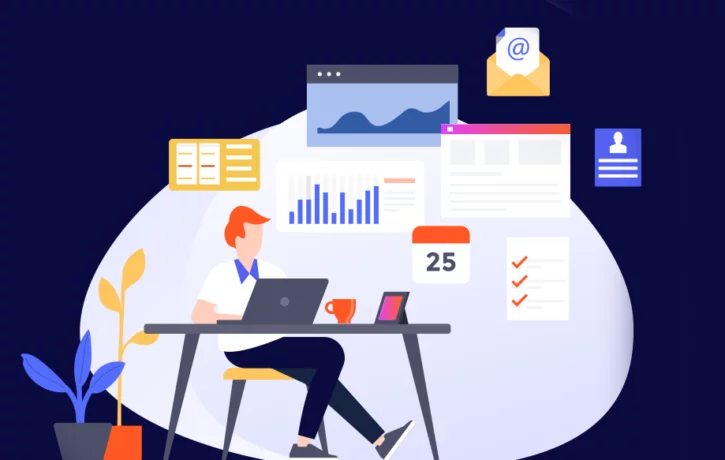Digital transformation promises to unleash unprecedented levels of employee productivity and innovation. Yet many companies are seeing their productivity levels flatline.
Disappointing outputs are just one part of the problem. On top of that, employee stress, frustration, and demoralization are on the rise.
These are the symptoms of digital context switching, an inevitable but costly product of digital transformation. Left untreated, the burden of digital context switching can undermine your digital strategy and harm the overall employee experience.
What is digital context switching?
Although it’s often discussed in the realm of IT, the effects of digital context switching afflict all employees in the age of digital transformation.
It’s defined as the process of moving between tasks and projects across different platforms.
Unlike task switching (reading emails and then writing one, for example), digital context switching requires your brain to reorient itself to an entirely new context. When it happens over and over throughout the day, all of this extra “reorienting” time adds up to a whole lot of waste and lost efficiency.
Dive Deeper: Digital Transformation 2.0 — What’s Holding You Back?
The human brain isn’t wired for multi-tasking
For most knowledge workers, the need to efficiently move between tasks is a must. But it rarely happens that employees  get to handle a task from start to finish with no interruptions in between.
get to handle a task from start to finish with no interruptions in between.
More often, they attempt to juggle multiple tasks across different contexts concurrently. Each time they switch tasks, they need to clear out their cognitive load to make space for new information. When it’s time to return to the original task, they need to refresh their memories of what they were doing before.
Imagine you’re in the middle of a project that requires you to keep several critical items at the top of your cognitive load. Anything that takes you out of this concentration — whether a co-worker asks you a question, you get an urgent email, or the task itself requires you to locate information on another platform — will disrupt this short-term memory.
Each time your employees must operate in a different context, they need to dedicate time to reorienting themselves and recalling various different pieces of information. This period of time increases when the tasks are of greater complexity, which means productivity ultimately declines.
The consequences of digital context switching reach far and wide
Of course, when we find out employees are wasting bulks of time answering the question, “Now, where was I?” we’re inclined to quantify the lost productivity.
After all, our digital transformation strategies are designed to improve this very business metric. On top of greater outputs, we expect digital investments to empower our employees to think more innovatively, take full advantage of advanced features, and make fewer mistakes.
Instead, digital context switching results in lost time and more human error, which comes with its own set of consequences.
The psychological costs are also taxing. Digital context switching forces employees to spread their attention too thin, which is mentally exhausting and frustrating. Employees who work long hours but still struggle to make deadlines and complete their tasks will become demoralized and less satisfied at work.
Like what you’re reading? Subscribe to the blog for top insights delivered right to your inbox!
Lift the burden
Like I said before, digital context switching is unavoidable. As business strategy and operations become more dependent  on digital technology, it’s unlikely that the number of enterprise platforms will decrease any time soon.
on digital technology, it’s unlikely that the number of enterprise platforms will decrease any time soon.
It’s up to you to lift the burden from your employees’ shoulders. Finding a remedy for digital context switching requires a holistic approach — from encouraging better task management practices to deploying digital solutions designed to make switching between tasks seamless.
A digital solution for a digital problem
One such tool is WalkMe’s Digital Adoption Platform (DAP). The DAP is built to drive user adoption across all applications, from web and desktop apps to mobile systems. Powered by artificial intelligence, the DAP is wired to analyze thousands of user behavior touchpoints, detect inefficiencies, and deploy real-time guidance.
Even when your employees must toggle between different interfaces, the DAP makes the “reorienting” period instant and ensures they never feel lost or confused. On-demand, in-app support is available around the clock.
In addition to greater productivity within apps, the DAP helps eliminates the effects of digital context switching by making the act of transitioning interfaces seamless.
While each individual platform has its own features and characteristics, adding the DAP provides a new layer of consistency to help users complete tasks with ease.
Take a tactical approach to productivity management
By pairing a powerful digital solution with proven productivity management practices, you can drastically reduce the  burden of digital context switching.
burden of digital context switching.
For instance, if your employees must handle a high workload with fast turnaround times, creating a system for prioritizing tasks and delegating them effectively is a good start. Initiating a queue for handling requests from other departments might be applicable.
Basic time management principles, such as reserving certain periods of the day for checking email, can also help reduce interruptions.
When your employees’ productivity is on the line, failing to address the toll of digital context switching will drag down key performance metrics, as well as the employee experience. By taking a proactive stance, you can prevent frustration before it occurs, keep employee outputs high, and promote a more efficient work environment.
WalkMe’s Digital Adoption Platform (DAP) transforms the user experience in today’s overwhelming digital world. Using artificial intelligence, engagement, guidance, and automation, WalkMe’s transparent overlay assists users to complete tasks easily within any enterprise software, mobile application or website. Discover how a DAP can revolutionize your business.

